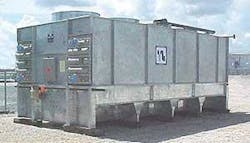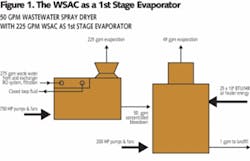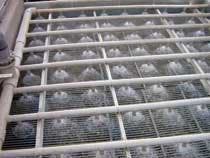The Wet Surface Air Cooler – A First Stage Evaporator for Zero Liquid Discharge
by Chuck Marchetta
With the high importance of water quality and conservation, it’s not surprising that zero liquid discharge (ZLD) regulations are becoming more common in many plants around the world. Many of these plants use spray dryers or crystallizers to evaporate and dispose of thousands of gallons of wastewater generated by the facility each day. This equipment is expensive both to purchase and to operate. There’s an alternative. By using a wet surface air cooling system as a first stage evaporator, the quantity of wastewater to be disposed of can be reduced while at the same time cooling or condensing liquids or gases. Such systems can significantly reduce initial capital cost, operating cost and total input energy required to meet ZLD requirements.
In an upcoming project, Niagara Blower Co. will engineer and manufacture a Wet Surface Air Cooler (WSAC) to be used in a ZLD regulated plant. The design calls for 100% of the plant’s discharge water to flow into the cooler for first stage evaporation. The system will evaporate a portion of the total discharge stream in order to reduce the downstream flow to the spray dryer equipment. At the same time, it will produce cold water for use elsewhere in the plant. It will evaporate and concentrate the majority (about 80%) of the wastewater by spraying it over the outside of specially designed closed-loop tube bundles. For a heat source (on the inside of the tubes), water that would otherwise be cooled in the primary cooling tower is used. The highly concentrated blowdown (pre-concentrated wastewater) from the cooler is then sent to the spray dryers for final evaporation and disposal.
Since this cooler system’s parasitic power usage is made up only of low-head pumps and fans, the total energy required to treat the same amount of wastewater is reduced. Compared to the original design, the cost to operate the cooler/spray dryer combination requires far less energy than operating the spray dryer by itself. The dryers use heat energy, usually in the form of natural gas or electricity. With the new combination, the operating cost is reduced by 75% based on a cost per gallons per minute (gpm) evaporated. Not only does the new configuration reduce operating costs, but it contributes to earning “green credits” by reducing the total amount of water and input energy required by the facility.
In addition, because total flow to the dryers is reduced, overall capital costs to purchase the dryers is less. The cooler for this project will feature alloy tubes and special materials of construction to resist corrosion from the aggressive low quality concentrated spray water. Even with the relative high cost for construction materials, the net result is a 50% reduction in total capital cost for cooling and wastewater disposal equipment.
Not only will the cooler/sprayer system evaporate wastewater, but it also produces cooling water for the facility, about 85°F at design conditions. It operates thermally as a direct approach to the wet bulb temperature (100°F dry bulb; 75°F wet bulb). In such a system, the process fluid to be cooled is pumped through the tube bundles. This technology’s basic principle is heat is rejected directly from the process stream by means of latent (evaporative) heat transfer. The system operates in lieu of a cooling tower and heat exchanger combination. Warm process fluids or vapors are cooled in the closed-loop tube bundles. Open-loop water is sprayed and air is induced over the tube bundle resulting in the cooling effect. The process fluid being cooled never comes in contact with the environment. Since the circulating spray water isn’t pumped through a heat exchanger (as in an open tower), higher cycles of concentration can be achieved with lower quality water.
There are a wide variety of material and component configurations to optimize each heat transfer application based on the stream to be cooled or condensed (inside the tubes) and the quality of the spray water (outside the tubes). The Wet Surface Air Cooler from Niagara Blower has been utilized as a water treatment device in zero or limited discharge plants because of the ability to operate with low quality water at high cycles of concentration. It can also use a wide variety of sources as makeup, including cooling tower blowdown, runoff and demineralizer blowdown, FGD wastewater, well water, agricultural runoff, produced water and seawater.
About the Author: Chuck Marchetta is an applications engineer for Niagara Blower Co., of Buffalo, NY. The company is a design-build manufacturer for engineered solutions to heat transfer applications at power, process, refinery, food and brewing facilities worldwide since 1904. Its customized product lines include closed-loop evaporative WSAC and “No-Frost”® liquid desiccant dehumidification systems. Contact: 716-875-2000, [email protected] or niagarablower.com




